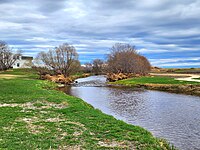| Icelandic River | |
|---|---|
 The Icelandic River meandering away from Arborg, Manitoba. The Icelandic River meandering away from Arborg, Manitoba. | |
 | |
| Location | |
| Country | Canada |
| Province | Manitoba |
| Physical characteristics | |
| Source | Spruce Lake system |
| • coordinates | 50°52′47″N 97°44′51″W / 50.87972°N 97.74750°W / 50.87972; -97.74750 |
| • elevation | 302 m (991 ft) |
| Mouth | Lake Winnipeg |
| • location | Riverton, Manitoba |
| • coordinates | 51°01′35″N 96°57′42″W / 51.02639°N 96.96167°W / 51.02639; -96.96167 |
| • elevation | 218 m (715 ft) |
| Basin size | 1,336 km (516 sq mi) |
| Discharge | |
| • location | 50°57′53″N 97°02′14″W / 50.96472°N 97.03722°W / 50.96472; -97.03722 |
| • average | 3.5 m/s (120 cu ft/s) |
| • minimum | 0 m/s (0 cu ft/s) |
| • maximum | 108 m/s (3,800 cu ft/s) |
The Icelandic River is a river in the Interlake Region of Manitoba. Its headwaters are near the Spruce Lakes system located by Manitoba Highway 68.
The river is the source of an agricultural area in the north of the Interlake, flowing through and supporting the communities of Arborg and Riverton. The East Interlake Conservation Area has assessed that 81% of the land use of the Icelandic River watershed is used for an agricultural purpose.
The Icelandic River is also one of the most important spawning sites on the western shores of Lake Winnipeg for fish such as walleye, though recreation and agricultural activities have inhibited this capability recently.
The river's mouth is located at Riverton, where the water flows into Lake Winnipeg.
Etymology
The river was originally known as White River, appearing on John Arrowsmith's map of 1821.
In the early days of settlement, the river was the main "road", by boat in summer and by ice in winter. Hardwoods such as elm and maple grew along its banks. In spring and early summer, it provided walleye, jackfish, mullets, catfish, and goldeye.
It was later known as the Whitemud River, appearing on John Palliser's map of 1865; however, confusion with the other Whitemud River in Manitoba prompted the name to be changed.
In 1875, Whitemud was renamed "Icelander's River" by an Icelandic expedition, as it marked the northern border of New Iceland. This name became Icelandic River.
This name was later given to the community found at the mouth of the river on Lake Winnipeg. The community of Icelandic River was later changed to Riverton.
See also
References
- ^ "Icelandic River / Washow Bay Creek Integrated Watershed Management Plan" (PDF). Government of Manitoba. November 28, 2006. Retrieved March 22, 2023.
- "Monthly Discharge Data for ICELANDIC RIVER NEAR RIVERTON (05SC002) [MB]". Environment Canada. Retrieved March 23, 2023.
- "Town of Arborg History". Town of Arborg. Retrieved March 22, 2023.
- ^ "East Interlake Conservation District: Icelandic River Watershed District Riparian Assessment Survey - With Emphasis on the Icelandic River and Associated Drainas" (PDF). East Interlake Conservation District. 2007. p. ii. Retrieved March 22, 2023.
- "Icelandic River and Washow Bay Creek Integrated Watershed Management Plan." Manitoba Environment and Climate. Retrieved 2024-03-30.
- ^ Hamilton, William (1978). The Macmillan Book of Canadian Place Names. Toronto: Macmillan. p. 59. ISBN 0-7715-9754-1.
- "History". Arborg Heritage Village. Retrieved March 23, 2023.
- "HRB Pamphlets: The Settlement of New Iceland". www.mhs.mb.ca. Retrieved 2024-03-30.
- "New Iceland". Rural Municipality of Gimli. Retrieved March 22, 2023.
External links
This article related to a river in Manitoba, Canada is a stub. You can help Misplaced Pages by expanding it. |